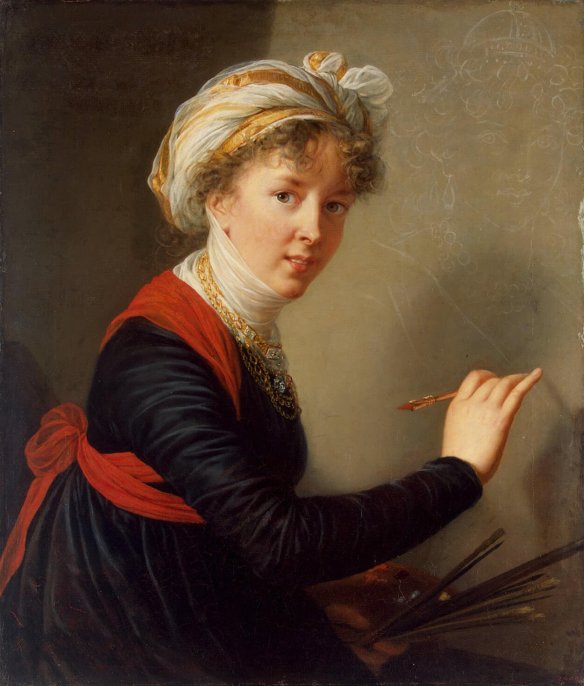
This blog has already written earlier on women artists.
I will write on this subject again now, basing myself on, eg, Elke Linda Buchholz, Women Artists, Munich 2003.
Also, after the first time, for the second time on Marie Louise Elisabeth Vigée-Lebrun and Constance Mayer, both living in the time of the French revolution.
With Mayer being twenty years younger, and also politically different from Vigée-Lebrun’s monarchism.
Marie Louise Elisabeth Vigée Lebrun (1755-1842) was from the French nobility, and painted at the court of King Louis XVI and Queen Marie Antoinette.
Like some other women artists, she had had the advantage as a young girl, contrary to the vast majority of girls then, that her father painted (he was a member of the official Academy), and was willing to teach it to his daughter.
Her class advantages also contributed to her career, as did her marriage to an influential art dealer, and, it was said, her love affair with the king’s finance minister, Charles Alexandre, viscount de Calonne.
Contrary to what is often written on artists like Rembrandt and Goya, she depicted her powerful subjects idealizingly, flatteringly.
In 1789, when the French revolution started, she fled France.
She could continue to paint portraits of monarchs and aristocrats: now of foreign countries like Russia, often at war with revolutionary France and trying to restore the royal dynasty there.
As Napoleon Bonaparte consolidated his power in the early nineteenth century, the more radical sides of the revolution dropped away.
Making himself emperor, Napoleon would even bring back a monarchy, though on a different basis than the ancien régime one.
Already before that, in 1802, Ms Vigée Lebrun was welcome to return to France (as was viscount Calonne then).

Constance Marie Mayer-Lamartinière (1775-1821), was a neo-classicist.
Contrary to the luxury of the French royal court in Versailles, neo-classicists often glorified the ancient Roman republic as an age of simplicity and virtue, an example for the young French republic.
Constance Mayer, daughter of a bourgeois office employee, had learned painting from Jacques-Louis David, a radical revolutionary depicting scenes from Roman antiquity as examples for two thousands years later.
According to Peter Huijs, page 21, Ms Mayer:
had both a personal and artistic relationship to famous artist Pierre-Paul Prud’hon.
At many of the paintings signed by him, she worked intensely.
When she came to the conclusion that Pierre-Paul had different plans and would never marry her, not even in the case that his mentally ill wife would die, she cut her throat with his razor.
Related articles
- Elisabeth Vigée Le Brun: A Novel (americangirlsartclubinparis.wordpress.com)
- Naslund’s new novel: a writer and painter balance life and art (seattletimes.com)
- Knowledge is Power! The Classical Era (firehelicopterinthesky.wordpress.com)
- Blog #4 Classical (amandargentz.wordpress.com)



i love your paintinting
LikeLike
Thank you karen!
LikeLike
why you use blogsome? thank you
LikeLike
Hi mrilham, I use Blogsome because I used to blog on ModBlog. That was bought by new owners and went down the drain. The server is rarely down at Blogsome.
LikeLike
Pingback: Women artists and French impressionism | Dear Kitty. Some blog
Pingback: Adelaïde Labille-Guiard, woman artist of the French revolution | Dear Kitty. Some blog
Pingback: Resistance and art, from the 1871 Paris Commune to today’s Iraq war. Part I | Dear Kitty. Some blog
Pingback: Women artists’ history | Dear Kitty. Some blog
Pingback: 500 Years of Female Portraits in Western Art | Dear Kitty. Some blog
Pingback: American art historian Linda Nochlin, RIP | Dear Kitty. Some blog
Pingback: Painter Raphael on film, review | Dear Kitty. Some blog
Pingback: French painter Eugène Delacroix, New York exhibition | Dear Kitty. Some blog